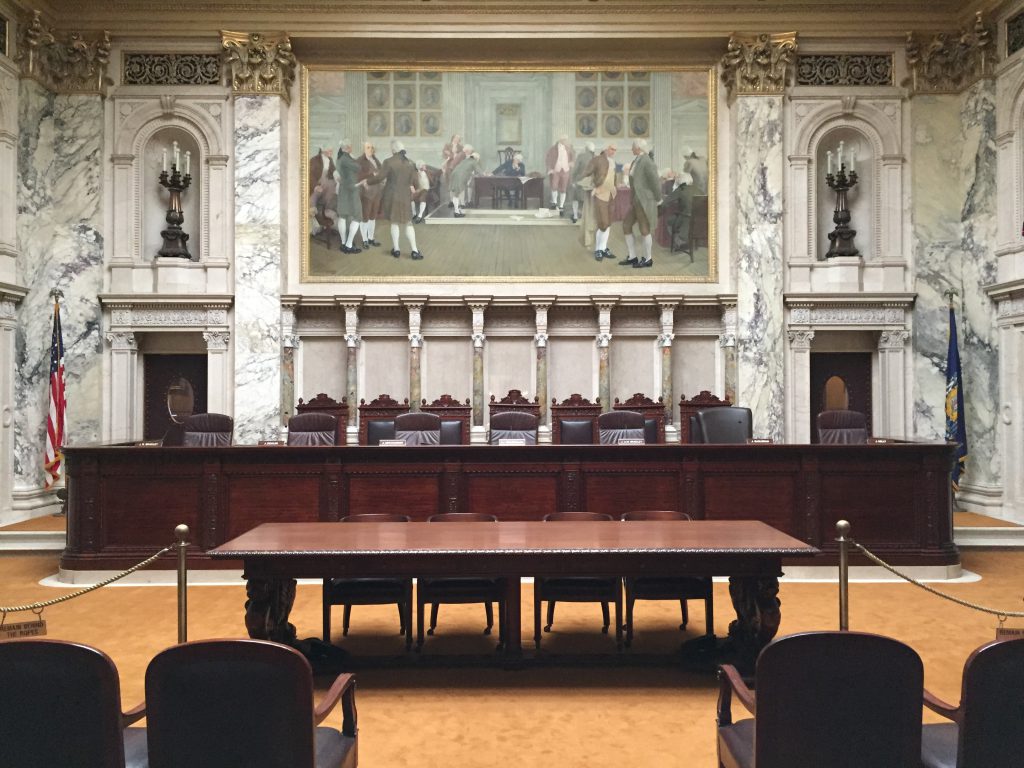Court Rulings Against Evers Sow Confusion
Supreme Court overrules vetoes and health orders with vague language offering no guidance.
In 1964, U.S. Supreme Court Justice Potter Stewart used this phrase to describe how he knew something should be ruled as obscene: “I know it when I see it.”
Potter’s vague definition could become the unofficial Wisconsin Supreme Court motto, if it keeps ruling against Gov. Tony Evers. The Supreme Court’s conservative majority has ruled against the Democratic governor three times in eight weeks.
Consider the court’s July 10 finding that three Evers partial vetoes of the 2019-21 state budget, passed by Republicans, were illegal.
Why were they illegal? In essence, “we know illegal vetoes when we see them.”
“Five justices conclude that the vetoes to the school bus modernization fund are unconstitutional. The same five also conclude that the vetoes to the local roads improvement fund are unconstitutional. Four justices conclude that the vetoes to the vapor products tax are unconstitutional. Five justices conclude that the vetoes to the vehicle fee schedule are constitutional.”
Dissenting, Justice Ann Walsh Bradley noted that the five- and four-justice majorities offered no guidance on governors’ powers to partially veto spending bills passed by the Legislature.
In 1930, voters gave governors partial veto authority over spending bills. But, after former Governors Tony Earl and Tommy Thompson used partial vetoes to creatively delete letters, figures, words and sentences, and then stitch what was left to create pet programs, voters twice limited those partial-veto powers through state referendums.
In its July 10 ruling, the court could have clarified what governors can and cannot do with partial vetoes. Instead, Walsh Bradley noted, “In an important case like this … we instead sow confusion.
She added: ”Evidence of the lack of clarity is highlighted by the very fact that this case has generated four separate [opinions] with various rationales. And not one of them has garnered a majority vote of this court. Thus, we are left with no clear controlling rationale or test for the future.”
One phrase from Roggensack’s decision — “I break no new ground with this decision” — seemed to agree with Walsh Bradley.
Evers and his chief lawyer, Ryan Nilsestuen, have said the court offered no guidance on another critical question – what exactly are the emergency powers of a governor? – when it struck down the Safer at Home order of Health Services Secretary Andrea Palm on May 13.
To fight the spread of the lethal COVID-19 virus, Evers had Palm issue an order requiring residents to stay home, close businesses and limit the size of gatherings. But a lawsuit challenging Palm’s order was filed by Republican legislative leaders
Translation: “We know a cabinet secretary acting illegally when we see it.”
For his part, Evers has refused to defy the Supreme Court’s May 13 order, saying he has no confidence that any new order would survive another legal challenge by Republicans.
In his official statement on the Supreme Court ruling, Evers said: “Republican legislators have convinced four justices to throw our state into chaos.”
Thompson, the Republican governor from 1987 until 2001, would have not been intimidated. Thompson’s governing theory was, “Be bold. It’s easier to ask for forgiveness than permission. Don’t apologize unless you’re caught.”
Thompson would have first tried to negotiate an emergency order with legislators, avoiding a lawsuit. If there was no deal, Thompson would have issued daily COVID-19 emergency orders, sending this public message: “I’m doing all I can to protect public health and safety. If you legislators want to stop me — risking the lives of your family members, neighbors and constituents — I’ll see you in court!”
In its third recent ruling against Evers, the court upheld Republicans’ December 2018 “lame duck” laws that limited the powers of the incoming Democratic governor and Democratic Atty. Gen. Josh Kaul. Those laws rebalanced power between the executive and legislative branches of state government, the court decided.
Steven Walters is a senior producer with the nonprofit public affairs channel WisconsinEye. Contact him at stevenscotwalters@gmail.com
If you think stories like this are important, become a member of Urban Milwaukee and help support real, independent journalism. Plus you get some cool added benefits.
More about the Coronavirus Pandemic
- Governors Tony Evers, JB Pritzker, Tim Walz, and Gretchen Whitmer Issue a Joint Statement Concerning Reports that Donald Trump Gave Russian Dictator Putin American COVID-19 Supplies - Gov. Tony Evers - Oct 11th, 2024
- MHD Release: Milwaukee Health Department Launches COVID-19 Wastewater Testing Dashboard - City of Milwaukee Health Department - Jan 23rd, 2024
- Milwaukee County Announces New Policies Related to COVID-19 Pandemic - David Crowley - May 9th, 2023
- DHS Details End of Emergency COVID-19 Response - Wisconsin Department of Health Services - Apr 26th, 2023
- Milwaukee Health Department Announces Upcoming Changes to COVID-19 Services - City of Milwaukee Health Department - Mar 17th, 2023
- Fitzgerald Applauds Passage of COVID-19 Origin Act - U.S. Rep. Scott Fitzgerald - Mar 10th, 2023
- DHS Expands Free COVID-19 Testing Program - Wisconsin Department of Health Services - Feb 10th, 2023
- MKE County: COVID-19 Hospitalizations Rising - Graham Kilmer - Jan 16th, 2023
- Not Enough Getting Bivalent Booster Shots, State Health Officials Warn - Gaby Vinick - Dec 26th, 2022
- Nearly All Wisconsinites Age 6 Months and Older Now Eligible for Updated COVID-19 Vaccine - Wisconsin Department of Health Services - Dec 15th, 2022
Read more about Coronavirus Pandemic here
More about the Lame Duck Laws
- Supreme Court Hears Case on Legislature’s Power - Sarah Lehr - Apr 3rd, 2025
- Four Years Later, State’s Lame Duck Law Still Faces Court Challenge - Shawn Johnson - Jan 17th, 2023
- Judge Rules Against Law Giving Legislators Power Over Attorney General Settlements - Shawn Johnson - May 11th, 2022
- State Supreme Court Dismisses AG’s Lame-Duck Lawsuit - Ruth Conniff - Mar 25th, 2021
- Kaul Sues Legislature Over Lame Duck Laws - Melanie Conklin - Nov 24th, 2020
- AG Kaul Announces Legal Action to Allow DOJ to Again Enforce Wisconsin Laws Without Unconstitutional Legislative Interference - Josh Kaul - Nov 23rd, 2020
- Vos Thinks Lame-Duck Session Didn’t Go Far Enough - Melanie Conklin - Jul 31st, 2020
- The State of Politics: Court Rulings Against Evers Sow Confusion - Steven Walters - Jul 20th, 2020
- Court Tosses Dems’ Lame-Duck Suit - Laurel White - Jul 16th, 2020
- Op Ed: State High Court Nullifies 2018 Election - James Rowen - Jul 12th, 2020
Read more about Lame Duck Laws here
The State of Politics
-
RNC Brings Fame to Gen Z Party Leader
 Jul 15th, 2024 by Steven Walters
Jul 15th, 2024 by Steven Walters
-
Wisconsin’s Republican Roots Run Deep
 Jul 8th, 2024 by Steven Walters
Jul 8th, 2024 by Steven Walters
-
Feuding Supreme Court Justices Need a Break
 Jul 1st, 2024 by Steven Walters
Jul 1st, 2024 by Steven Walters






















